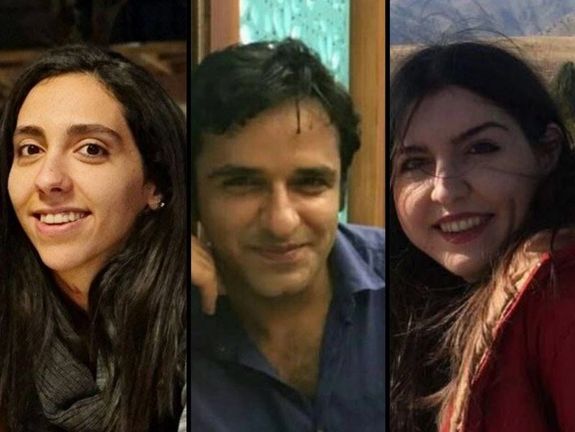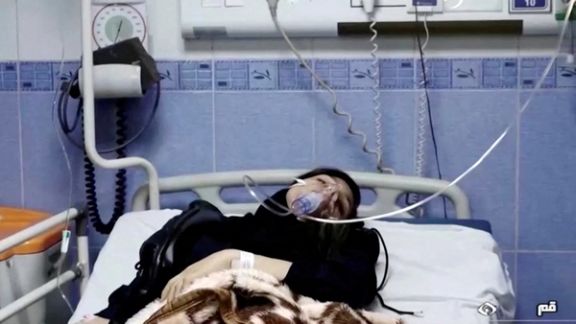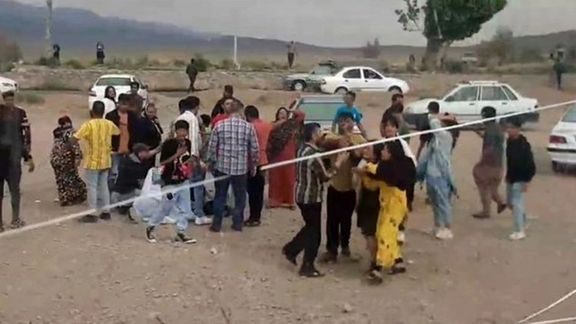Iran Indicts Three Activists Protesting To Chemical Attacks On Schools

Three student activists in Iran have been summoned and indicted after protesting the serial poisoning of schoolgirls across the country.

Three student activists in Iran have been summoned and indicted after protesting the serial poisoning of schoolgirls across the country.
Zia Nabavi, a former political prisoner, and student activist who was summoned to the Evin court together with two other activists, Fereshteh Tousi and Hasti Amiri, announced Monday that they have been accused of "propaganda against the state”.
The students from Tehran Allameh University held a gathering on March 7 to protest against the chemical attacks on students which began on November 30 in Qom.
Close to 300 schools and thousands of students have been targeted by chemical attacks with as yet, no clear answers from the government and no convictions made.
Nabavi is no stranger to the brutal regime’s crackdowns, having previously served nine years of a 10-year sentence on charges of "creating unease in the public mind" before being released in February 2018.
The attacks have mostly affected girls’ schools to quash the wave of anti-regime unrest which followed the death in custody of Mahsa Amini, with women leading the Woman, Life, Freedom revolutionary movement and rejecting the mandatory hijab.
Hundreds of girls have since been hospitalized with symptoms including respiratory distress, numbness in their limbs, heart palpitations, headaches, nausea, and vomiting.
Ordinary Iranians have been suspicious of the involvement of the regime itself, or religious extremists protected by the regime, calling the attacks “state terrorism,” although the regime has denied responsibility and even staged arrests of suspects after widespread protests.
Popular belief is that such large-scale and coordinated attacks cannot happen without the green light of regime authorities.

As the government in Iran fails to stop recurring chemical attacks on girls’ schools, parents are moving to take protection into their own hands.
Following increasing attacks in the past two weeks, photos emerged on social media of parents standing guard outside their daughters’ schools.
Moreover, the Coordination Council of Iranian Teachers' Trade Associations issued a statement on Monday, stressing the necessity of forming grassroot groups to protect students. The council also called for the formation of a "human chain around schools.”
Earlier on Monday, several schools in the Kurdish-majority city of Sanandaj were attacked by the mysterious gas for the second time in the past two weeks.
Also on Monday, schools were attacked in the cities of Hamedan, Mehrshahr and Karaj, among others. An unknown number of girls were taken to hospital following these attacks.
The council also said that two teachers were also hospitalized in the intensive care unit after one of the attacks in Karaj, near the capital Tehran.
In the statement, the Council pointed out that the poisonings have been happening for over six months and despite haphazard denunciations authorities have taken no action to stop them.

"While we are witnessing the continuation of these crimes, the suspicion of the government's support and orchestration of the attacks have become evident,” read the statement.
“The country's police force is unable to ensure the safety of the children, but at the same time, it has devoted its efforts to threatening freedom-loving women, who resist pressure so as to have a choice on choosing their clothing," the council added.
Urging students, their families, and teachers to join hands and set up groups to protect the schoolgirls, the council said, If the perpetrators of these catastrophic crimes are not identified, tried and punished, the teachers will inevitably hold classes in the street to save the lives of the students and will ask the popular groups to protect them with a human chain."
In the past few days, families of students staged several rounds of protest rallies urging officials to hold classes virtually rather than at schools to protect children from further attacks that began in November.
Critics of the regime say the attacks are part of a crackdown on protests, a claim denied by officials who have claimed the symptoms are the result of mass hysteria. Every now and then in the past six months, state media reported the arrest of perpetrators but never has the regime announced the identities of the detainees, or provided information about their motives, date of trial and the investigation.
The only people whose arrests became certain were the people who released videos of the aftermath of the attacks. The Ministry of Islamic Guidance has sent a notice to the local media to censor the news related to the attacks.
Close to 300 schools were targeted in the past Iranian year ending on March 20 without any apparent serious effort by the government to identify and pursue the perpetrators, nor to explain to terrified parents and students what was happening.
Thousands of students have been affected, mostly girls, with hundreds hospitalized with symptoms including respiratory distress, numbness in their limbs, heart palpitations, headaches, nausea, and vomiting.

A 59-year-old Iranian woman died of cardiac arrest in hospital Monday after a fight broke out when vigilantes assaulted a member of her family over hijab.
A video, posted on social media after the incident shows the woman, whose name has not been disclosed, on the ground and scuffles between people on the scene at the parking lot of Mahan Garden, a tourist attraction 25km from Kerman, capital of the Eastern Kerman Province. The woman died at a hospital later.
Social media users have reported that the deceased and her family members were visitors from the southern port city of Bandar Abbas.
The video was taken from inside a bus which carried the Revolutionary Guards (IRGC) affiliated Basij militia members and their families who were in Kerman to visit the grave of slain Qods Force Commander Qassem Soleimani.
Apparently, the Basij members ordered a member of the woman’s family to cover her hair, leading to an argument and a scuffle.
“Let her die!”, one of the Basij women on the bus exclaims when another one points out that the woman on the ground has died.
Scuffle between Basijis and people at Mahan Garden’s parking after a woman collapsed.
Ali Babaei, governor of Kerman, confirmed the death of the 59-year-old woman and injury of several others in the group fight, which he claimed had been “personal”. He added that those responsible for the incident were arrested by the police but did not offer further details.
A judiciary official, Yousef Sobhani, has said that an investigation has been launched into the incident and “any possible crime would be seriously dealt with.”
The footage was initially widely shared by hardliners on social media because it showed a few people attacking the Basijis and throwing stones at the bus but was later removed from most accounts as it appeared to have backfired.
In the past few weeks, hardliners have intensified their efforts to enforce veiling laws more forcefully to put a stop to women’s increasing defiance of the compulsory hijab. Since popular protests after Mahsa Amini died at the hands of the morality police in September, many women walk in the streets without hijab. The clerical regime is determined not to allow unveiled women to appear outside their homes and prevent more women from flouting hijab rules in as the hot summer season arrives.
Such efforts include encouragement of hardliners to take the matter into their own hands and carry out their religious duty of “calling to virtue and forbidding wrong”. This includes shutting businesses for their customers’ defiance of hijab, and “hijab warning” text messages sent by the police to nearly everyone who uses a mobile phone, including some men.
Warning ‘hijab-less’ women, however, in several cases has gone well beyond “verbal” and ended in violence.
Emergency responders attending to a woman who had a panic attack during a hijab fight at shopping arcade in Babol.
A video from the CCTV of a convenience store in Shandiz near the religious city of Mashhad went viral on social media in early April that showed a man dumping a large tub of yogurt on the head of a ‘hijab-less’ woman and her mother, after an argument as he demanded from her to cover her head.
Some of the people present on the scene came to the defense of the mother and daughter. The attacker was also a member of the Basij.
Another video that became viral on social media in mid-April showed a young woman having a panic attack at a shopping arcade in Babol in northern Iran. The incident happened as a fight broke out when Basij militia tried to arrest some shopkeepers over hijab and fired their guns into the air during the scuffle.
The police later denied that shots had been fired or the hijab incident had caused the young woman’s panic attack.
Hijab incidents are now becoming a daily occurrence. At Tehran University on Monday students staged a rally outside the campus security office after a fight broke out between them and guards who had used violence against female students over hijab. The security detained two female students but later released them.
Many say on social media that women will not allow to be bullied again into wearing the hijab.

Families of political prisoners executed in Iran’s in 1988 are meeting Ohio state legislators to push for the sacking of a college professor accused of being involved in the killings.
According to a statement released by relatives of the victims, they will meet with 10 state legislators to ask them to withhold state and federal funding to Oberlin College until Mohammad Jafar Mahallati, a former Iranian UN envoy who covered up the mass killings, is fired.
"On April 28 we will hold a protest at Oberlin College, and then we will participate in the Oberlin city rally to hail the courage of the Iranian people in standing up against the clerical regime," read the statement.
Mahallati, currently a professor of religion at Oberlin College, is accused of playing a role as an accomplice in the 1988 prison massacre.
The executions were carried out based on a fatwa by Iran's then-supreme leader, Ruhollah Khomeini, against the MEK which carried out a wave of bombings in Iran and struck an alliance with Saddam Hussein during the 1980-88 war.
The exact number of prisoners executed during the purge of prisoners is not known but according to Amnesty International, the Iranian authorities "forcibly disappeared" and "extrajudicially executed" around 5,000 between July and September 1988.
Mahallati maintains that he was unaware of the executions despite Amnesty International’s numerous urgent notices to Iran calling for an end to the killings which were widely reported by the media.

An Iranian lawmaker has warned about an impending medicine crisis following an inadequate budget allocation.
Homayoun Sameyah, a member of the Parliament's Health Commission, announced that the budget needed to procure medicine and medical equipment is 150 thousand billion tomans (nearly 3 billion USD), but the fund allocated by the government is less than half this figure.
“Our prediction is that in the coming months, the issue of medicine and medical equipment shortage will worsen,” he said on Monday.
Despite the warnings, Minister of Health Bahram Einollahi is underplaying the crisis, claiming that “most medicines are available, and there will be no problem regarding the supply of pharmaceuticals this year.”
Medicine shortages in more economically deprived areas of the country have already reached crisis point with medical staff at hospitals in the southeastern city of Zahedan citing shortages of IV fluid, insulin, and inhaler sprays.
In the last Iranian year, ending March 20, the medicine crisis intensified as people witnessed multifold increase in prices. The government scrapped an import subsidy for food and medications last year.
Although the national currency bounced back in the past month it is still down 50 percent compared to six months ago. The country imported around 100 million euros of medicines a month from Europe alone in 2022 and also large quantities from China and India.

Official figures show a major drop in Iran’s exports to China, India and Turkey in the first quarter of 2023.
Turkey's Official Statistics Center has reported that the country's imports from Iran have fallen to $450 million, a 22% drop. The numbers announced by the Indian Ministry of Commerce also show a 6% drop in imports from the Islamic Republic, hitting less than $162 million.
Official Chinese customs data also shows that imports from Iran were $2.9 billion in the first quarter of 2023, which is a decline of more than 41% compared to the first quarter of 2022. The reasons for the decline in trade with Iran's major Asian ally are not clear, but during recent months, Iranian economic experts and businessmen had said that Russian products are dominating the Chinese market.
Amin Ebrahimi, CEO of Iran’s Khuzestan Steel Company, claims that by supplying steel below global prices, Russia has captured the markets that Iran had created for itself during four decades of sanctions.
Meanwhile, Secretary General of the Petrochemical Industry Employers Association, Ahmad Mahdavi Abhari, told ILNA news agency on Saturday that the export of urea and methanol has decreased by 2.5 million tons since March 21, due to lack of natural gas needed at plants.
He said this will lead to a $700 million drop in exports because compared to last year the figure has decreased by 20-25%.
The Islamic Republic’s petrochemical sector needs natural gas to operate, and producers sustain losses because of shortages.